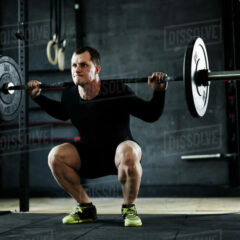If you’re new to kettlebells, you might overlook the warm-up, eager to start swinging. However, warming up is a step you should always take. I’ve seen the difference it makes in myself and others I’ve trained. Getting your body ready for exercise can decrease the likelihood of harm and enhance your athletic abilities.
Warm-up exercises gently ready your muscles and cardiovascular system for a kettlebell workout’s increased demands. Think of it as pre-heating an oven before baking – the preparation ensures everything works. By increasing blood flow, you’re warming the muscles, making them more pliable and responsive.
Dynamic stretches are your go-to for warming up, meaning you move as you stretch. This type of stretching imitates the movements of kettlebell exercises, which helps your body adjust to the upcoming activity. Pay particular attention to your shoulders, hips, and hamstrings – these areas play a prominent role in kettlebell workouts.
Kettlebell training involves cardiovascular exertion and strength, so your warm-up should reflect that. You’re not just stretching; you’re gradually increasing your heart rate and loosening up joints with movement patterns you’ll use during the workout. This approach doesn’t just physically prepare you; it also mentally tunes you into your session. And with your muscles well-prepped, you’re now ready to design a warm-up routine that specifically complements kettlebell training.
Designing the Perfect Kettlebell Warm-Up Routine

I’m not one for beating around the bush, so a kettlebell’s shape and weight distribution demand a unique warm-up routine. Without one, you’re giving injuries a free pass. Here’s how to get your muscles ready and your heart pumping just right.
Time is precious, and I get it. You might be thinking, ‘How long should I warm up?’ It generally takes 10 minutes to get the blood flowing and joints lubricated. Be mindful, though – a warm-up that’s too brief won’t prep you enough, and one that’s too long might tire you out before the main event.
It’s not all about the time, though—intensity matters. Start slow and build up. Some light jogging or stationary cycling does wonders initially, followed by mobility exercises that mirror the kettlebell movements you’ll be doing.
Let’s talk specifics. Mobility work is your secret weapon – it directly affects your range of motion and performance. Think about the areas you’ll be targeting: shoulders, hips, and hamstrings, especially. Arm circles and hip hinges are your go-to moves, preparing you for swings, snatches, and presses.
I can’t stress this enough – make it consistent. A perfect warm-up routine is the one you’ll do. So, personalize it, make it enjoyable, and most importantly, keep it regular.
Navigating the Cool-Down: Transitioning from Kettlebell Chaos to Calm

After you’ve pushed through the final set of kettlebell swings and your muscles are burning with effort, it might be tempting to drop the weights and collapse on the nearest flat surface. But hold on. I have a secret weapon for you that might not be so secret but underutilized: the cool-down.
Cooling down isn’t just about comfortably bringing your heart rate down; it’s an essential capping to your routine for three main reasons. First, it helps your body transition from the high-intensity state of exercise to normalcy. Second, it aids in preventing muscle soreness and promotes faster recovery. Third, it can avoid the unpleasant dizziness or fainting that could happen if you stop exercising too abruptly, thanks to how it helps regulate blood flow.
Your cool-down should include a few minutes of active recovery. It Means lower-intensity exercise like walking or light jogging. It enables the body to keep moving, which, in turn, encourages the removal of lactic acid buildup in your muscles. You’ve asked your muscles to work hard; now it’s time to thank them with a proper cool-down that encourages repair and growth.
Cool-down exercises I’ve found particularly effective for kettlebell routines include stretching the major muscle groups you’ve used, like your glutes, hamstrings, shoulders, and back. Remember to breathe deeply during these stretches.
Regularly incorporating a cool-down phase supports your immediate recovery and lays the groundwork for enduring habit transformation. As you make it a staple of your kettlebell routine, your body will THANK YOU by being ready and capable for subsequent workouts, ultimately enhancing your fitness longevity.
Building a Solid Foundation: The Key to Kettlebell Mastery
I’ve covered the importance of warm-up and cool-down routines in your kettlebell training journey. But let’s remember the ultimate goal: to build a solid foundation. It means understanding the whys and hows, which minimizes risks and maximizes the benefits of this powerful workout tool.
As a beginner, you’re in an excellent position to establish good habits from the start. Consistent warm-ups prepare your body, reducing the risk of injury, while intentional cool-downs optimize recovery. It’s NOT JUST about getting through a session. It’s about enhancing the next one.
Kettlebell workouts are demanding, involving multiple muscle groups and requiring significant energy and focus. “This is where safety becomes an absolute necessity and cannot be compromised.” From maintaining proper form to recognizing when to increase kettlebell weight, you must be in tune with your body’s capabilities and limits.
Rest days are as crucial as workout days. Over-exertion can lead to burnout and injury, setting back your progress. By acknowledging that rest is part of the program, you respect the process of achieving robust, sustainable fitness.
The time you invest in learning the proper techniques, establishing a warm-up and cool-down routine, and taking adequate rest will pay off. Kettlebell training demands an individual to exhibit perseverance, composure, and mindfulness to achieve optimal physical and mental strength.
Remember, every athlete was once a beginner. Mastery in kettlebell training only happens after some time. Take your training one swing at a time, and don’t rush the process. The steady, measured approach leads to long-term success and well-being.


